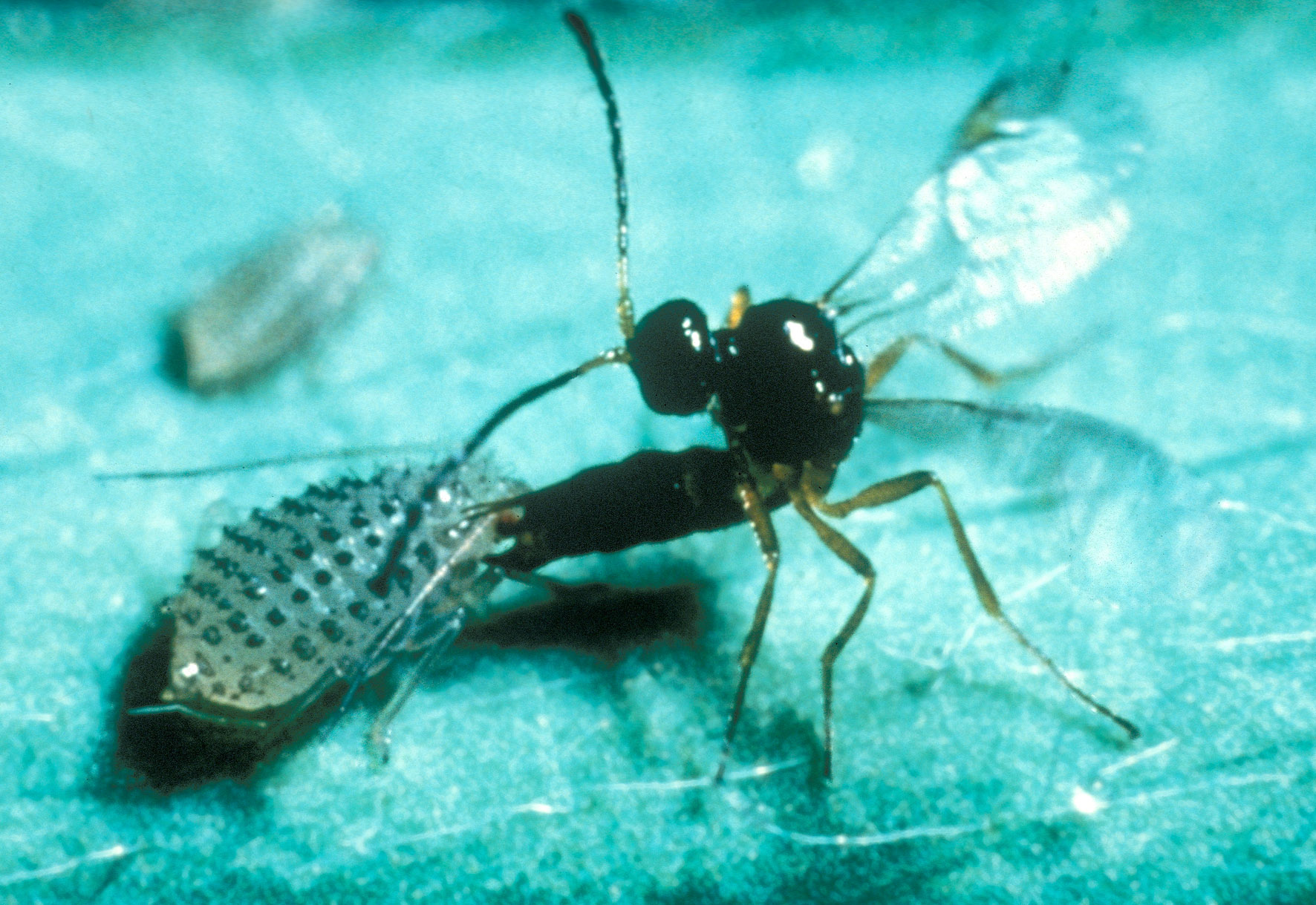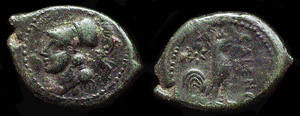|
Aphelinid
The Aphelinidae are a moderate-sized family of tiny parasitic wasps, with about 1100 described species in some 28 genera. These minute insects are challenging to study, as they deteriorate rapidly after death unless extreme care is taken (e.g., preservation in ethanol), making identification of most museum specimens difficult. The larvae of the majority are primary parasitoids on Hemiptera, though other hosts are attacked, and details of the life history can be variable (e.g., some attack eggs, some attack pupae, and others are hyperparasites). Males and females may have different hosts and different life historie They are found throughout the world in virtually all habitats, and are extremely important as biological control agents. The oldest fossils are known from the Eocene aged Baltic Amber. They are difficult to separate from other Chalcidoidea except by subtle features of the wing venation and other difficult characters, and the family appears to be paraphyletic, so is lik ... [...More Info...] [...Related Items...] OR: [Wikipedia] [Google] [Baidu] [Amazon] |
Parasitic Wasp
Parasitoid wasps are a large group of hymenopteran superfamilies, with all but the wood wasps ( Orussoidea) being in the wasp-waisted Apocrita. As parasitoids, they lay their eggs on or in the bodies of other arthropods, sooner or later causing the death of these host (biology), hosts. Different species specialise in hosts from different insect orders, most often Lepidoptera, though some select Coleoptera, beetles, Diptera, flies, or Hemiptera, bugs; the spider wasps (Pompilidae) exclusively attack spiders. Parasitoid wasp species differ in which host life-stage they attack: eggs, larvae, pupae, or adults. They mainly follow one of two major strategies within parasitism: either they are endoparasitic, developing inside the host, and koinobiont, allowing the host to continue to feed, develop, and moult; or they are ectoparasitic, developing outside the host, and idiobiont, paralysing the host immediately. Some endoparasitic wasps of the superfamily Ichneumonoidea have a mutuali ... [...More Info...] [...Related Items...] OR: [Wikipedia] [Google] [Baidu] [Amazon] |
Aphelinidae 2022 05 19 3302
The Aphelinidae are a moderate-sized family of tiny parasitic wasps, with about 1100 described species in some 28 genera. These minute insects are challenging to study, as they deteriorate rapidly after death unless extreme care is taken (e.g., preservation in ethanol), making identification of most museum specimens difficult. The larvae of the majority are primary parasitoids on Hemiptera, though other hosts are attacked, and details of the life history can be variable (e.g., some attack eggs, some attack pupae, and others are hyperparasites). Males and females may have different hosts and different life historie They are found throughout the world in virtually all habitats, and are extremely important as biological control agents. The oldest fossils are known from the Eocene aged Baltic Amber. They are difficult to separate from other Chalcidoidea except by subtle features of the wing venation and other difficult characters, and the family appears to be paraphyletic, so is lik ... [...More Info...] [...Related Items...] OR: [Wikipedia] [Google] [Baidu] [Amazon] |
Parasitoid
In evolutionary ecology, a parasitoid is an organism that lives in close association with its host (biology), host at the host's expense, eventually resulting in the death of the host. Parasitoidism is one of six major evolutionarily stable strategy, evolutionary strategies within parasitism, distinguished by the fatal prognosis for the host, which makes the strategy close to predation. Among parasitoids, strategies range from living inside the host (''endoparasitism''), allowing it to continue growing before emerging as an adult, to Paralysis, paralysing the host and living outside it (''ectoparasitism''). Hosts can include other parasitoids, resulting in hyperparasitism; in the case of oak galls, up to five levels of parasitism are possible. Some parasitoids Behavior-altering parasite, influence their host's behaviour in ways that favour the propagation of the parasitoid. Parasitoids are found in a variety of Taxon, taxa across the insect superorder Endopterygota, whose compl ... [...More Info...] [...Related Items...] OR: [Wikipedia] [Google] [Baidu] [Amazon] |
Bardylis (wasp)
''Bardylis'' is a small genus of chalcid wasps belonging to the family Aphelinidae The Aphelinidae are a moderate-sized family of tiny parasitic wasps, with about 1100 described species in some 28 genera. These minute insects are challenging to study, as they deteriorate rapidly after death unless extreme care is taken (e.g., .... There are presently 9 described species. References Aphelinidae Hymenoptera genera {{Chalcidoidea-stub ... [...More Info...] [...Related Items...] OR: [Wikipedia] [Google] [Baidu] [Amazon] |
Eriaporidae
Eriaporinae is a subfamily of chalcid wasps in the order Hymenoptera, family Pirenidae. There are 2 genera and 6 described species in Eriaporinae. Eriaporinae was formerly considered a subfamily of the family Aphelinidae The Aphelinidae are a moderate-sized family of tiny parasitic wasps, with about 1100 described species in some 28 genera. These minute insects are challenging to study, as they deteriorate rapidly after death unless extreme care is taken (e.g., .... Genera * '' Eunotiscus'' Compere, 1928 * '' Promuscidea'' Girault, 1917 References Further reading * * * Parasitic wasps Chalcidoidea {{chalcidoidea-stub Insects described in 1955 Hymenoptera subfamilies ... [...More Info...] [...Related Items...] OR: [Wikipedia] [Google] [Baidu] [Amazon] |
Allomymar
''Allomymar'' is a little-known monotypic genus of chalcid wasps belonging to the family Aphelinidae. The only species within the genus is ''Allomymar taitae'' and it is possible that ''Allomymar'' is synonymous with ''Encarsia ''Encarsia'' is a large genus of minute parasitic wasps of the family Aphelinidae. The genus is very diverse with currently about 400 described species and worldwide distribution. Noyes, J. S. 2003Universal Chalcidoidea database/ref> The number o ...''. References Aphelinidae Monotypic Hymenoptera genera {{Chalcidoidea-stub ... [...More Info...] [...Related Items...] OR: [Wikipedia] [Google] [Baidu] [Amazon] |
Aphelinus
''Aphelinus'' is a genus of parasitoid wasps. Several species in the genus (including ''A. albipodus'', '' A. asychis'' and ''A. varipes'') parasitize agricultural pests, such as the soybean aphid (''Aphis glycines'') or the Russian wheat aphid (''Diuraphis noxia''). About 100 species have been described. Partial species list *''Aphelinus abdominalis'' Dalman *''Aphelinus albipodus'' Hayat & Fatima *''Aphelinus asychis'' Walker *''Aphelinus certus'' Yasnosh *''Aphelinus chaonia'' Walker *''Aphelinus flaviventris'' Kurdjumov *''Aphelinus humilis'' Mercet *''Aphelinus lapisligni'' Howard *''Aphelinus mali'' (Haldeman) *''Aphelinus semiflavus'' Howard *''Aphelinus thomsoni'' Graham *''Aphelinus varipes ''Aphelinus'' is a genus of parasitoid wasps. Several species in the genus (including ''A. albipodus'', '' A. asychis'' and ''A. varipes'') parasitize agricultural pests, such as the soybean aphid (''Aphis glycines'') or the Russian wheat aphid ( ...'' (Foerster) References ... [...More Info...] [...Related Items...] OR: [Wikipedia] [Google] [Baidu] [Amazon] |
Aphytis (wasp)
Aphytis (), also Aphyte (Ἀφύτη) and Aphytus or Aphytos (Ἄφυτος), was an ancient Greek city in Pallene, the westernmost headland of Chalcidice. Around the middle of the 8th century BC colonists from Euboea arrived. The city became well known for its Temple of Dionysus, which appears to have been built in the second half of the 8th century BC. At Aphytis, Ammon was worshipped, at least from the time of the Spartan general Lysander, as zealously as in Ammonium, sanctuary in Libya. According to Pausanias, the patron of Aphytis, Ammon Zeus, appeared in a dream to Lysander and urged him to raise the siege, which he did. The Temple of Ammon Zeus, whose few remaining ruins date to the 4th century BC structure. During archaic and classical times Aphytis was a prosperous city, minting its own coins, which depicted the head of its patron, Ammon Zeus, the city's economy appears to have been mainly based on farming and vine-culture. Aristotle (Politics V,VI 1319 a14) mentions ... [...More Info...] [...Related Items...] OR: [Wikipedia] [Google] [Baidu] [Amazon] |
Aphelinus Mali
''Aphelinus mali'' is a parasitoid wasp that exploits the woolly apple aphid (''Eriosoma lanigerum''), a pest of apple trees. It is native to the northeastern United States but has been introduced to other parts of the world as a biological pest control agent. Description The adult ''A. mali'' is a tiny black wasp slightly smaller than its woolly aphid Host (biology), host. Its transparent membranous wings are longer than its abdomen and fold flat along its back. Although it can fly, it prefers to walk and jump, and often conceals itself under leaves. The larvae and pupae remain hidden inside the host; the larvae are yellow with red eyes, and the pupae are black. Distribution This parasitoid is a parasite of aphids, particularly woolly aphids and is native to the northeastern parts of the United States. It was introduced in 1928 to the orchards of the Pacific Northwest in the region of Hood River (Oregon), Hood River and spread naturally. It has since been introduced to many othe ... [...More Info...] [...Related Items...] OR: [Wikipedia] [Google] [Baidu] [Amazon] |
Botryoideclava
''Botryoideclava'' is a small genus of chalcid wasps belonging to the family Aphelinidae. Partial species list *''Botryoideclava bharatiya'' Subba Rao *''Botryoideclava thailandica ''Botryoideclava'' is a small genus of chalcid wasps belonging to the family Aphelinidae The Aphelinidae are a moderate-sized family of tiny parasitic wasps, with about 1100 described species in some 28 genera. These minute insects are challe ...'' Hayat, 1994 References Aphelinidae {{Chalcidoidea-stub ... [...More Info...] [...Related Items...] OR: [Wikipedia] [Google] [Baidu] [Amazon] |
Paraphyletic
Paraphyly is a taxonomic term describing a grouping that consists of the grouping's last common ancestor and some but not all of its descendant lineages. The grouping is said to be paraphyletic ''with respect to'' the excluded subgroups. In contrast, a monophyletic grouping (a clade) includes a common ancestor and ''all'' of its descendants. The terms are commonly used in phylogenetics (a subfield of biology) and in the tree model of historical linguistics. Paraphyletic groups are identified by a combination of synapomorphies and symplesiomorphies. If many subgroups are missing from the named group, it is said to be polyparaphyletic. The term received currency during the debates of the 1960s and 1970s accompanying the rise of cladistics, having been coined by zoologist Willi Hennig to apply to well-known taxa like Reptilia (reptiles), which is paraphyletic with respect to birds. Reptilia contains the last common ancestor of reptiles and all descendants of that ancestor exc ... [...More Info...] [...Related Items...] OR: [Wikipedia] [Google] [Baidu] [Amazon] |
Cales (wasp)
Cales was an ancient city of Campania, in today's ''comune'' of Calvi Risorta in southern Italy, belonging originally to the Aurunci/Ausoni, on the Via Latina. The Romans captured it in 335 BC and established a colony with Latin rights of 2,500 citizens. Cales was initially the centre of the Roman dominion in Campania. To the period after 335 belong numerous silver and bronze coins with the inscription ''Caleno''. It was an important base in the war against Hannibal, and at last refused further contributions for the war. Before 184 BC more settlers were sent there. After the Social War it became a ''municipium''. The fertility of its territory and its manufacture of black glazed pottery, which was even exported to Etruria, made it prosperous. At the end of the 3rd century BC it appears as a colony, and in the 5th century (AD) it became an episcopal see, which (jointly with Tano since 1818) it still is, though it is now a mere village. The cathedral, of the 12th century, has a ... [...More Info...] [...Related Items...] OR: [Wikipedia] [Google] [Baidu] [Amazon] |



